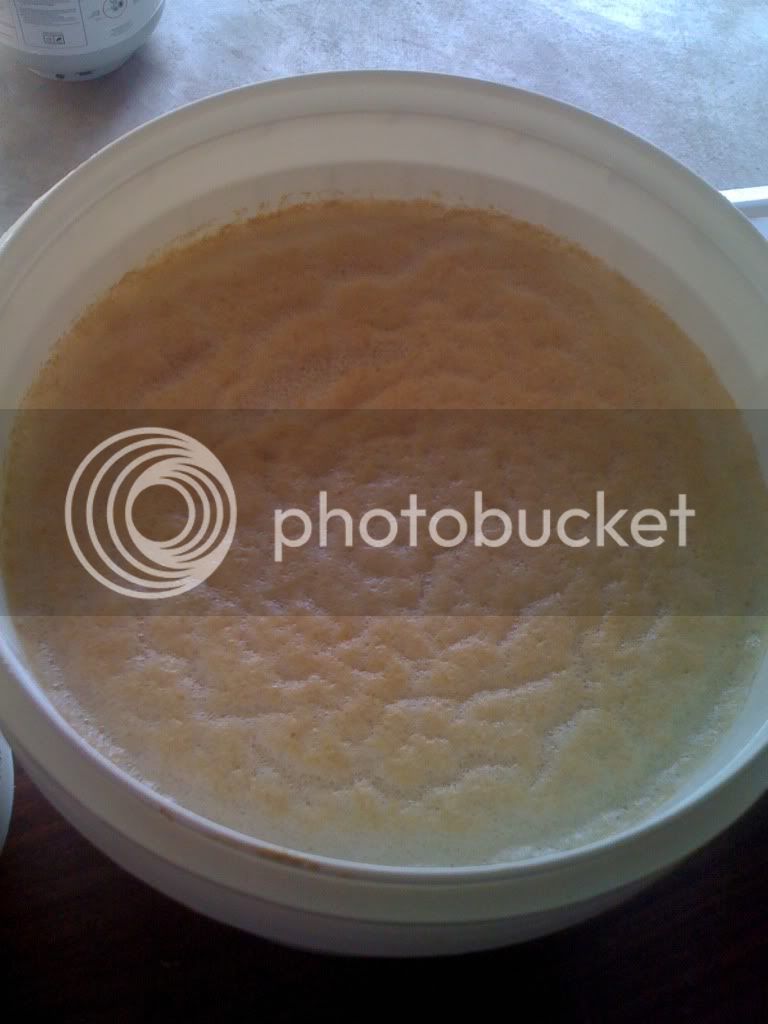xkred27
Member
Hello all! This may not be as pretty as elipsey's pellicle (never thought I'd ever type that) but it's cool none-the-less...
On a whim I decided to catch a second running off a 1.090 IIPA for my first parti gyle small beer. I used a bucket that had not been sanitized, but had been cleaned since its last use. I didn't have time to continue with the small beer that night, so I intended to proceed the next night. There was a lid on it, but the airlock hole was open. I accidently left it in my garage overnight and all the next day. Here in Little Rock we are suffering, like many, from extreme heat, and the temp definately exceeds 110 in my garage (it's a southern exposure, closed up with a fridge and freezer.) Domestic life wouldn't allow a brew session the next night, but I did move it inside to my 72 degree closet. So finally- 48 hours later- I opened the closet to brew and was nearly knocked over by the smell of beer. I popped the lid and this is what I found:

Here is the grain bill. The OG was 1.040.
Pale Malt (2 row), US 74.95%
Victory malt 15.01%
Flaked Rye 5.02%
Cara-Pils/Dextrine 2.51%
Caramel/Crystal 120 2.51%
So, my learned beer peers, questions:
1. Do you think this spontaneous fermentation is due to Pacman left behind in the bucket, or some strain of hell-spawn yeast that was strolling around in my garage?
2. Most importantly, can I drink it? It smelled like beer, though a little different from what I'm used to.
3. It was unhopped and unboiled. Comments? Should I dry hop it?
4. I put it in my incubator, currently at 68F. Is this advisable, or should I sweat it out in the garage?
5. Should I just pour it out and forget about it?
6. Is there anything special I should do to help it produce something useful, or should I just cross my fingers?
7. It looks like krausen and smells like beer, so it's not bacterial, right?
Thanks!
On a whim I decided to catch a second running off a 1.090 IIPA for my first parti gyle small beer. I used a bucket that had not been sanitized, but had been cleaned since its last use. I didn't have time to continue with the small beer that night, so I intended to proceed the next night. There was a lid on it, but the airlock hole was open. I accidently left it in my garage overnight and all the next day. Here in Little Rock we are suffering, like many, from extreme heat, and the temp definately exceeds 110 in my garage (it's a southern exposure, closed up with a fridge and freezer.) Domestic life wouldn't allow a brew session the next night, but I did move it inside to my 72 degree closet. So finally- 48 hours later- I opened the closet to brew and was nearly knocked over by the smell of beer. I popped the lid and this is what I found:

Here is the grain bill. The OG was 1.040.
Pale Malt (2 row), US 74.95%
Victory malt 15.01%
Flaked Rye 5.02%
Cara-Pils/Dextrine 2.51%
Caramel/Crystal 120 2.51%
So, my learned beer peers, questions:
1. Do you think this spontaneous fermentation is due to Pacman left behind in the bucket, or some strain of hell-spawn yeast that was strolling around in my garage?
2. Most importantly, can I drink it? It smelled like beer, though a little different from what I'm used to.
3. It was unhopped and unboiled. Comments? Should I dry hop it?
4. I put it in my incubator, currently at 68F. Is this advisable, or should I sweat it out in the garage?
5. Should I just pour it out and forget about it?
6. Is there anything special I should do to help it produce something useful, or should I just cross my fingers?
7. It looks like krausen and smells like beer, so it's not bacterial, right?
Thanks!



